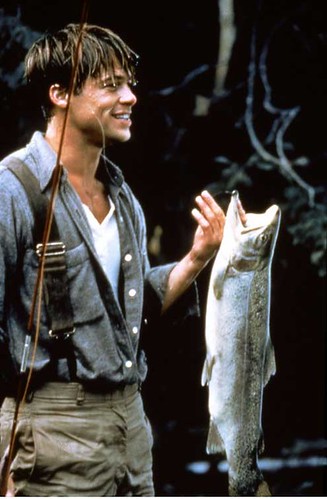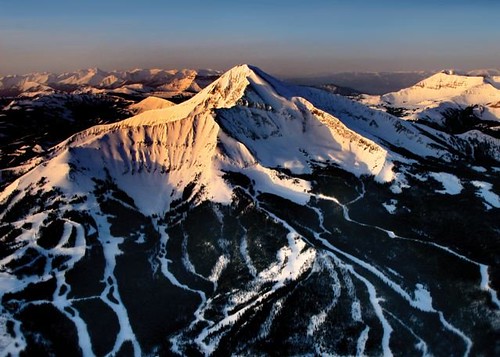Whistler Blackcomb, the alpine skiing venue for the 2010 Winter Olympics, offers the greatest downhill thrills in North America, especially since its “PEAK 2 PEAK” gondola was built to connect the two mountains. With its sprawling alpine bowls, top-of-the-world glaciers and lively pedestrian village at its base, B.C.’s ski goliath, located 90 minutes north of Vancouver, is unmatched for trail variety and international glamour.
Here in the East, I have to content myself with “loud powder,” the Yankee euphemism for the icy boilerplate that fastens itself to the slopes in Vermont and New Hampshire at this time of year. Of course, if you can ski on ice, you can ski on anything, but in truth there’s nothing to compare with gliding downhill on a cloud of new-fallen snow on a beautiful sunny day in the Rockies.
From Steamboat to Snowmass, Colorado is hands-down the most complete ski state in the nation. But it can be crowded. For purists, there’s only Utah’s “champagne powder,” which is as light and dry as talcum powder. But for me the Last Great Place for winter sports and just about everything else is that giant sleepy state in the northern Rockies, a place where the buffalo still roam: Montana.

With fewer than one million residents—that’s 6.2 persons per square mile–Montana is virgin territory. There are no crowds in Big Sky country, least of all at its leading ski resorts, where lift lines are virtually unknown. If you find elk sightings, untracked powder and backyard rodeos more appealing than trendy shops and chic cafes, Montana–more rawride, less chiffon—will make you happy.
Especially given what happened a few years ago. Prior to the 2005-06 ski season, the adjacent resorts of Big Sky and Moonlight Basin, located southwest of Bozeman, gateway to the high country, pooled their resources to form the largest interconnected trail network in America. A combined ski pass provides lift access to hundreds of acres of summit snowfields previously accessible only by hiking. It’s like going to Europe, known for its integrated ski resorts, without crossing the ocean.
Taken together, the two trail systems at Big Sky and Moonlight Basin offer 5,512 acres of skiiable terrain—Vail is close, but no U.S. ski resort offers more—as well as a lift-served vertical descent of 4,350 feet, second-biggest in the nation. Between them, the two resorts operate 23 lifts and maintain over 220 marked runs covering 110 miles on three separate mountains. More than quantity, the combined areas offer some of the most diverse terrain in the world, from powder-filled glades and steep mogul fields to groomed cruising trails up to six miles long. Best of all, the slopes are blanketed in more than 400 inches of snow each year. Do the math. That’s over 30 feet.
Because of the area’s famously low skier density, the expanded trail network provides tons of elbow room to downhill enthusiasts from November through April. “The interconnection unleashes access to some of the world’s best ski terrain, and it’s all located less than an hour from a major airport,” a state tourism official told me.
He might have added that the folks in these parts are friendly, too. Despite the fact that the fly-fishing scenes in A River Runs Through It were filmed on the nearby Gallatin, inspiring celebrities to acquire Montana ranchettes, the area is down to earth. Aspen it‘s not. When the locals talk about stargazing, they’re referring to heavenly bodies in the night sky, not Hollywood visitors.

Brad Pitt with a keeper in “A River Runs Through It”
Back to the slopes. With the purchase of what is now marketed as the “Biggest Skiing in America” combination ticket, your options are limited only by your imagination and ability.
A good place to start is Southern Comfort, a Big Sky high-speed quad that brings skiers to the summit of Andesite Mountain at 8,800 feet. From here, trails spread up, down and across the mountain’s flanks as far as the eye can see.
Skilled, fearless experts can take the Lone Peak Tram to the top of Lone Mountain, which rises to 11,166 feet and resembles a bulkier version of the Matterhorn. The Gullies and the Big Couloir trails, each marked double-black diamond, offer steep, powder-filled chutes cut through fingers of rock on a massive glacial cirque. There is no margin for error.
Trails on Lone Mountain’s sunny south face are more of the same: The double-black diamond Lenin and Marx trails funnel into the infamous Dictator Chutes, where risk borders on the totalitarian. If you’re a seasoned local or an Olympian slumming after the Games, you can yodel at the top of your lungs as you speed down what appears to be a narrow, rock-lined bobsled run tilted at 70 degrees.
Myself, I want to live to ski another day, so I stick to the broad, intermediate cruising trails cut through the evergreens. And while nearly 60 percent of Big Sky’s trails are in the advanced to expert category, at a resort this large there’s more than enough beginner and intermediate terrain to keep everyone happy. Including snowboarders, who can defy gravity in Big Sky’s giant half-pipe and spacious terrain parks.
The expansiveness of Big Sky, even by Rocky Mountain standards, is astounding. More than 150 trails adds up to a ton of terrain. I skied Liberty Bowl to the Mountain Mall base area, a run of six miles. The trails are not only long, they’re forgivingly wide. And with an average of 1.2 skiers per acre spread across 3,600 acres, it’s basically all yours. (With a scant 600,000 skier visits per year, a fraction of Vail’s numbers, Big Sky is a truly underutilized facility).
The resort is a throwback in more ways than one: The base lodge area is a time warp from the early 1970s. Those who grew up with metal skis and bear-trap bindings will recognize the architecture. Big Sky Resort was conceived and built by the late Chet Huntley, the legendary NBC newscaster who believed in the area but clearly was ahead of his time. Boyne USA Resorts, best known for its Michigan golf properties, has owned Big Sky for the past 35 years and is nearing the completion of a $400 million improvement plan for the mountain village and ski facilities.

Big Sky is truly magestic
Combination ticket holders can follow connector trails from Big Sky’s eastern slopes to Moonlight Basin, its network of trails carved from the north face of Lone Mountain. Amazingly, the mountain perspective from this side of the monolithic peak is totally different than Big Sky. I rode Six-Shooter, one of the nation’s first six-person chairlifts, to a vantage point below the summit. Fanned out across a steep, curving ridge were The Headwaters, a hair-raising line-up of finger-like, double-black diamond trails. Every 15 minutes or so, a brave soul would make a daredevil descent on a snowy path through the rocks. Previously accessible only by an arduous 30-minute hike, the Headwaters Lift now gives thrill-seekers access to some of North America’s most advanced in-bounds terrain. To use a golf metaphor, these trails are like Pine Valley from the tips–with far greater consequences for a mistake.
Nearby, the Lone Tree lift deposits skiers at the head of Lookout Ridge, an intermediate trail that serves up some of the most majestic alpine scenery anywhere. Immediately at hand is Fan Mountain, a pristine, tricorn-shaped peak capped with snow. Across the expansive Madison Valley, the Tobacco Root Mountains crowd the horizon in the far distance. The trail itself, a cruiser’s delight, weaves through spruce, fir and gnarly Bristlecone pines. The trails at Moonlight Basin were built on an environmentally sensitive model designed to limit tree removal and topsoil damage. Where Big Sky’s trails are vast boulevards paved across the face of the mountain, Moonlight’s trails are narrower and more naturalistic, with clumps of trees dividing many of the runs into left and right paths. Think of a lay-of-the-land golf course by Bill Coore-Ben Crenshaw adapted for skiing.
I stopped for a quick reviver at the Headwaters Grille, but the best place for après-ski refreshments at the resort is Moonlight Lodge. Clinging to the rocks of a massive, floor-to-ceiling fireplace in the Great Room of the Lodge are three long-haired mountain goats that appear poised to leap through the picture window and dash up the flanks of the mountain. And give those fearless locals and slumming Olympians a run for their money.

Moonlight Basin is the newest ski resort in the Rockies
